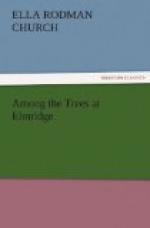“But that isn’t true, is it?” asked Edith.
“No, dear, not true of either the witches or the wood. But ignorant people believe a great many foolish things, and the leaves and twigs of the ash tree were thought to have peculiar virtue. In some places it was once the practice to pluck an ash-leaf in every case where the leaflets were of even number, and to say,
“’Even ash,
I do thee pluck,
Hoping thus to meet
good luck;
If no luck I get from
thee,
Better far be on the
tree.’”
“It sounds like what children say on finding a four-leafed clover,” said Clara.
“It is on the same principle,” was the reply, “for clover-leaves grow naturally in threes and ash-leaves in sevens. Both rhymes are equally silly where luck is concerned, and those who believe God’s words—that even ’the hairs of our head are all numbered’—will have no faith in ‘luck.’ In old times the ash was believed to perform wonderful cures of various kinds, and in remote parts of England a little mouse called the shrew-mouse bore a very bad character. If a horse or cow had pains in its limbs, they were said to be caused by a shrew-mouse running over it. Our forefathers provided themselves with what they called a shrew-ash, in order to meet the case. The shrew-ash was nothing more than an ash tree in the trunk of which a hole had been bored and a poor little shrew-mouse put in, with many charms and incantations happily long since forgotten.”
“And couldn’t the poor little mouse get out again?” asked Edith.
“I am afraid not, dear; and we can only rejoice that we did not live in those dark days. Among other beliefs in its virtues, the leaves and wood of the ash were regarded throughout Northern Europe as a protection from all manner of snakes, and in harvest-time children were suspended in their cradles from the branches of tall ash trees while their mothers were working in the harvest-field below. Even now serpents are said to dislike the tree so much that they will not come near it, and the leaf is considered a cure for the bite of a poisonous snake. I have been told that an ash-leaf rubbed on a mosquito-bite will at once take out the sting and itching, and no better remedy can be found for the sting of a bee or a wasp.”
“It’s ever so much nicer than mud,” said Clara, who had rather a talent for getting into hornets’ nests.
“But the mud, you see, is always to be had,” replied Miss Harson, “while ash-leaves do not grow everywhere; and I do not know that they have any power to cure the sting.
“The other species of ash found in this country are not so important as the white, but the black ash is remarkable as the slenderest deciduous tree of its height to be found in the forest. It is often seventy or eighty feet tall, with a trunk not more than a foot around. The color of the trunk is a dark granite-gray and the bark is rough. The wood is remarkable for its toughness, and for making baskets the Indians prefer it to any other, except the trunk of a young white oak.




